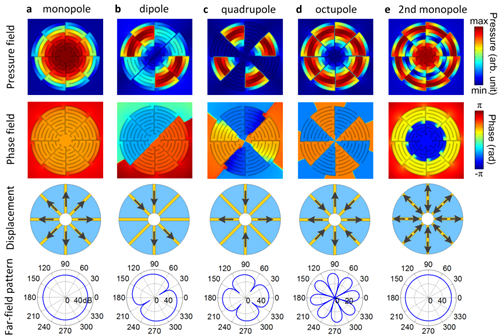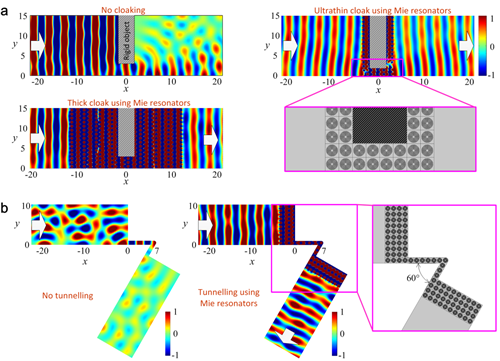Acoustic metamaterials offer great flexibility for manipulating sound waves and promise unprecedented functionality, ranging from transformation acoustics, super-resolution imaging to acoustic cloaking. However, the design of acoustic metamaterials with exciting functionality remains challenging with traditional approaches using classic acoustic elements such as Helmholtz resonators and membranes. These LC-resonance-based acoustic metamaterials usually have considerable absorption loss, fabrication complexity, and an anisotropic response associated with low symmetry, which limit the practical applications.
After demonstrating an ultraslow-fluid-like particle with intense artificial Mie resonances, Prof. LIU Xiaojun’s group at the Key Laboratory of Modern Acoustics, Nanjing University and the State Key Laboratory of Acoustics, Chinese Academy of Sciences, constructs an ultra-sparse metasurface for blocking low-frequency sound, which is a great challenge in science and engineering.
The proposed two-dimensional (2D) ultraslow-fluid-like unit cell can generate Mie resonances with monopolar, dipolar and multipolar characteristics, as shown in Fig. 1, which can exhibit distinct response behavior with respect to the previous reports. Eigenstate analysis and effective parameter retrieval show two individual negative bands in the single-size unit cell, one of which exhibits a negative bulk modulus supported by the monopolar Mie resonance, whereas the other exhibits a negative mass density induced by the dipolar Mie resonance. The unique single-negative nature is used to develop an ultra-sparse subwavelength metasurface with a high reflectance for low-frequency sound. Prof. Liu’s group demonstrated a 0.15λ-thick, 15%-filling ratio metasurface with an insertion loss over 93.4%.
The findings can enable flexible control of acoustic waves to realize versatile functional devices with superior performance, such as negative refraction, super-resolution imaging system, invisible cloaking, sound insulators/filters, acoustic tunnelling and so on.
"This work has opened a new route for constructing artificial Mie resonances, which can be used for applications like sound blocking and sound wave tunneling (see Fig. 2)”, as commented by one reviewer of Nature Materials.
This research entitled “Ultra-sparse metasurface for high reflection of low-frequency sound based on artificial Mie resonances” has been published online in Nature Materials on September 1, 2015.
The research was funded by the National Basic Research Program of China, NSFC, SRFDP and State Key Laboratory of Acoustics, CAS.

Fig. 1 | Field distributions of acoustic Mie-resonance modes in air supported by the unit cell. a-e, Acoustic modes of the artificial monopole, dipole, quadrupole, octupole and second monopole, respectively. The first and second rows depict the distributions of pressure and phase fields (blue/red for small/large values), respectively. In the third row, the arrows indicate the displacements in the physical model equivalent to the realistic unit cell. In the fourth row, far-field patterns reconfirm the field distributions. Excellent agreement is observed (Image by Prof. LIU Xiaojun’s group).

Fig. 2 | Acoustic cloaking/tunnelling by using artificial Mie resonators. a, Upper-left: pressure map showing the sound scattering by a rigid object (shaded region). The white arrows indicate the directions of wave propagation. Lower-left: resulting map when the object is embedded in a ρeff-near-zero metamaterial slab made of artificial Mie resonators. Note that the cloak is thick, like conventional designs. Right: efficient cloaking by ultrathin cloak with only two layers of Mie resonators. b, Acoustic tunnelling through a narrow channel with 120° bent angle. Note that the energy transmittance is 87.5% (right) by using the line of the Mie resonators while it becomes to be 3% (left) for the case without the Mie resonators (Image by Prof. LIU Xiaojun’s group).
Contact:
Dr. LIU Xiaojun, Professor
1. Key Laboratory of Modern Acoustics, School of Physics, Collaborative Innovation Center of Advanced Microstructures, Nanjing University, Nanjing 210093
2. State Key Laboratory of Acoustics, Chinese Academy of Sciences, Beijing 100190, China
Tel: +86-25-83593617
Fax: +86-25-83315557
Email: liuxiaojun@nju.edu.cn


